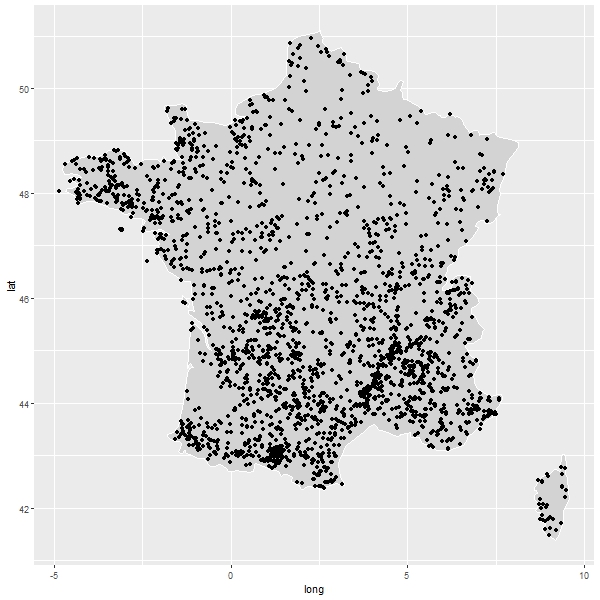Export coordinates to gpx via R
library(data.table)
library(rgdal)
library(ggmap)
export.gpx <- function(DATA, output) {
latslongs <- SpatialPointsDataFrame(coords=DATA[, .(lon, lat)], data=DATA, proj4string =CRS("+proj=longlat + ellps=WGS84"))
writeOGR(latslongs, dsn=output,
dataset_options="GPX_USE_EXTENSIONS=yes",layer="waypoints",driver="GPX", overwrite_layer = T, )
data <- data.table(x = readLines(output))
data <- data[grep("extension", x, invert = T)]
data[, x := gsub("ogr:url", "url", x)]
data[, x := gsub(" \\<url", " <url", x)]
data
write.table(data$x, output, quote = F, row.names = F, col.names = F)
}
fr
# lon lat
# 1: 4.089971 43.78390
# 2: 0.404444 44.46160
# 3: 5.536906 45.57675
# 4: 5.226620 43.38701
# 5: 0.780782 46.17596
# ---
# 2297: 5.322941 44.09015
# 2298: 6.405710 45.28262
# 2299: 6.971918 43.66684
# 2300: 2.802928 44.92323
# 2301: 3.287963 47.94342
export.gpx(fr, "output.gpx")
I can then open them easily on Locus app for example, and you can add how you want tag specific to gpx like <url> or <name> by just having other columns in your table.
Here an output example:
<?xml version="1.0"?>
<gpx version="1.1" creator="GDAL 3.5.2" xmlns:xsi="http://www.w3.org/2001/XMLSchema-instance" xmlns:ogr="http://osgeo.org/gdal" xmlns="http://www.topografix.com/GPX/1/1" xsi:schemaLocation="http://www.topografix.com/GPX/1/1 http://www.topografix.com/GPX/1/1/gpx.xsd">
<metadata><bounds minlat="37.121190100000000" minlon="-9.090287300000000" maxlat="43.583060500000002" maxlon="3.840409000000000"/></metadata>
<wpt lat="40.1854354" lon="-5.0472789">
<name>Casa Verde Sierra de Gredos</name>
<url>hidden</url>
<ogr:lat>40.1854354</ogr:lat>
<ogr:lon>-5.0472789</ogr:lon>
<ogr:Country>es</ogr:Country>
</wpt>
<wpt lat="42.8278614" lon="-5.5240025">
<name>Arbolio</name>
<url>hidden</url>
<ogr:lat>42.8278614</ogr:lat>
<ogr:lon>-5.5240025</ogr:lon>
<ogr:Country>es</ogr:Country>
</wpt>
<wpt lat="41.2491051" lon="1.2969289">
<name>Dasca Vives</name>
<url>hidden</url>
<ogr:lat>41.2491051</ogr:lat>
<ogr:lon>1.2969289</ogr:lon>
<ogr:Country>es</ogr:Country>
</wpt>
You can also easily plot them:
library(ggmap)
world <- data.table(map_data("world"))
ggplot(world[region %like% "France"])+
geom_map(map = world, aes(long, lat, map_id = region), color = "white", fill = "lightgray", size = 0.1)+
geom_point(data = fr, aes(lon, lat))

